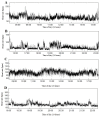Heavy Physical Work: Cardiovascular Load in Male Construction Workers
- PMID: 27023574
- PMCID: PMC4847018
- DOI: 10.3390/ijerph13040356
Heavy Physical Work: Cardiovascular Load in Male Construction Workers
Abstract
This study aimed to elucidate cardiovascular loads (CVL) in construction workers during work and leisure by relative heart rate (RHR) over several days. Furthermore, we sought to evaluate the level of CVL in relation to individual factors, work ability, musculoskeletal pain and subjective general health. From a group of 255 construction workers responding to the baseline questionnaire, the CVL during work and leisure time was determined by recording RHR in 42 workers over 3-4 days. Almost 60% of the workday was spent below 20% RHR. The mean RHR during work for all participants was 16% RHR, with large differences between professions. On average, the 42 workers spent 14% of the workday at a RHR above 33%, and four subjects (10%) had a mean RHR above 33% during work. Eight (19%) of the participants had a mean length of their workday exceeding calculated maximal acceptable work time. Seven persons (17%) experienced on average one or more episode(s) of 5 min or more continuously above 33% RHR. The cardiovascular load at work was significantly associated with age and V̇O(2max), but not with work ability, musculoskeletal pain or subjective general health.
Keywords: construction work; general health; musculoskeletal pain; physical demands; work ability.
Figures




Similar articles
-
Musculoskeletal health and work ability in physically demanding occupations: study protocol for a prospective field study on construction and health care workers.BMC Public Health. 2014 Oct 16;14:1075. doi: 10.1186/1471-2458-14-1075. BMC Public Health. 2014. PMID: 25318646 Free PMC article.
-
Cardiovascular strain of sawmill workers in South-Western Nigeria.Int J Occup Saf Ergon. 2013;19(4):607-11. doi: 10.1080/10803548.2013.11077016. Int J Occup Saf Ergon. 2013. PMID: 24321639
-
Effects of a Participatory Ergonomics Intervention With Wearable Technical Measurements of Physical Workload in the Construction Industry: Cluster Randomized Controlled Trial.J Med Internet Res. 2018 Dec 19;20(12):e10272. doi: 10.2196/10272. J Med Internet Res. 2018. PMID: 30567694 Free PMC article. Clinical Trial.
-
Relationship between maximum acceptable work time and physical workload.Ergonomics. 2002 Mar 15;45(4):280-9. doi: 10.1080/00140130210123499. Ergonomics. 2002. PMID: 12028725
-
Physical workload, leisure-time physical activity, obesity and smoking as predictors of multisite musculoskeletal pain. A 2-year prospective study of kitchen workers.Occup Environ Med. 2012 Jul;69(7):485-92. doi: 10.1136/oemed-2011-100453. Epub 2012 Apr 26. Occup Environ Med. 2012. PMID: 22539656 Clinical Trial.
Cited by
-
Is high aerobic workload at work associated with leisure time physical activity and sedentary behaviour among blue-collar workers? A compositional data analysis based on accelerometer data.PLoS One. 2019 Jun 6;14(6):e0217024. doi: 10.1371/journal.pone.0217024. eCollection 2019. PLoS One. 2019. PMID: 31170169 Free PMC article.
-
Risk Perception and Coping Behavior of Construction Workers on Occupational Health Risks-A Case Study of Nanjing, China.Int J Environ Res Public Health. 2021 Jul 1;18(13):7040. doi: 10.3390/ijerph18137040. Int J Environ Res Public Health. 2021. PMID: 34280977 Free PMC article.
-
Assessing the Impact of Work Activities on the Physiological Load in a Sample of Loggers in Sicily (Italy).Int J Environ Res Public Health. 2022 Jun 23;19(13):7695. doi: 10.3390/ijerph19137695. Int J Environ Res Public Health. 2022. PMID: 35805360 Free PMC article.
-
The Impact of Body Posture on Heart Rate Strain during Tree Felling.Int J Environ Res Public Health. 2022 Sep 6;19(18):11198. doi: 10.3390/ijerph191811198. Int J Environ Res Public Health. 2022. PMID: 36141462 Free PMC article.
-
Respiratory Inductance Plethysmography to Assess Fatigability during Repetitive Work.Sensors (Basel). 2022 Jun 2;22(11):4247. doi: 10.3390/s22114247. Sensors (Basel). 2022. PMID: 35684868 Free PMC article.
References
-
- Bink B. The physical working capacity in relation to working time and age. Ergonomics. 1962;5:25–18. doi: 10.1080/00140136208930548. - DOI
-
- Bonjer F.H. Actual energy expenditure in relation to the physical working capacity. Ergonomics. 1962;5:29–31. doi: 10.1080/00140136208930549. - DOI
-
- Åstrand P.O., Rodal K., Dahl H.A., Strømme B.S. Textbook of Work Physiology. 4th ed. Human Kinetics Publishers, Inc.; Champaign, IL, USA: 2003. Applied Work Physiology; pp. 503–540.
Publication types
MeSH terms
LinkOut - more resources
Full Text Sources
Other Literature Sources

